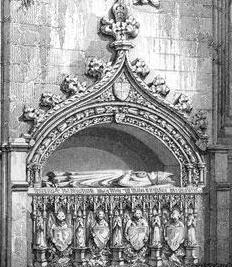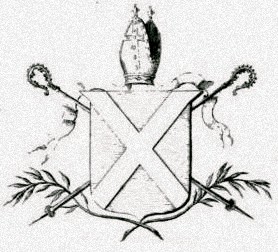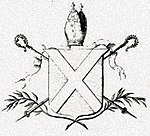Related Research Articles
The Bishop of Dunkeld is the ecclesiastical head of the Diocese of Dunkeld, one of the largest and more important of Scotland's 13 medieval bishoprics, whose first recorded bishop is an early 12th-century cleric named Cormac. However, the first known abbot dates to the 10th century, and it is often assumed that in Scotland in the period before the 12th century, the roles of both bishop and abbot were one and the same. The Bishopric of Dunkeld ceased to exist as a Catholic institution after the Scottish Reformation but continued as a royal institution into the 17th century. The diocese was restored by Pope Leo XIII on 4 March 1878; it is now based in the city of Dundee.
The Lord Chancellor of Scotland was a Great Officer of State in the Kingdom of Scotland.

The Bishop of St. Andrews was the ecclesiastical head of the Diocese of St Andrews and then, from 14 August 1472, as Archbishop of St Andrews, the Archdiocese of St Andrews.
John Scotus was a 12th-century Bishop of St. Andrews and Dunkeld.
Robert de Stuteville was Bishop-elect of St Andrews and Bishop of Dunkeld. Robert was dean of Dunkeld as early as 1253, when he was elected to the bishopric of St Andrews on 28 June that year. His election was opposed by the king, Alexander III, and by the bishopric's Céli Dé chapter. The prior and the canons sent Robert to Rome, but a delegation of the king, including Abel de Golynn, was also sent, and the result was that Robert's election was quashed.

James Kennedy was a 15th-century Bishop of Dunkeld and Bishop of St. Andrews, who participated in the Council of Florence and was the last man to govern the diocese of St. Andrews purely as bishop. One of the Gaelic clan of Carrick he became an important figure in the government of the minority of King James III of Scotland as well as founder of St Salvator's College, St Andrews.
Thomas Stewart was an illegitimate son of King Robert II of Scotland. In 1380, Avignon Pope Clement VII provided Thomas with the Archdeaconry of the Bishopric of St. Andrews, as well as the canonry of Stobo in the Bishopric of Glasgow. In 1389, the king petitioned and obtained for Thomas from the Pope the right to hold the deanery of the Bishopric of Dunkeld along with his other offices, and in 1393, the Pope provided a canonry in the Bishopric of Brechin. In this period, Archdeacon Thomas obtained a Bachelor of Canon Law at the University of Paris.
William de Bondington was a 13th-century Chancellor of Scotland and a bishop of Glasgow.
Robert Blackadder was a medieval Scottish cleric, diplomat and politician, who was abbot of Melrose, bishop-elect of Aberdeen and bishop of Glasgow; when the last was elevated to archiepiscopal status in 1492, he became the first ever archbishop of Glasgow. Archbishop Robert Blackadder died on 28 July 1508, while en route to Jerusalem on pilgrimage.
Richard de Inverkeithing was a 13th-century cleric from Scotland, probably from Inverkeithing in Fife. He was a Chamberlain of King Alexander II of Scotland and Bishop of Dunkeld.
Clement was a 13th-century Dominican friar who was the first member of the Dominican Order in Britain and Ireland to become a bishop. In 1233, he was selected to lead the ailing diocese of Dunblane in Scotland, and faced a struggle to bring the bishopric of Dunblane to financial viability. This involved many negotiations with the powerful religious institutions and secular authorities which had acquired control of the revenue that would normally have been the entitlement of Clement's bishopric. The negotiations proved difficult, forcing Clement to visit the papal court in Rome. While not achieving all of his aims, Clement succeeded in saving the bishopric from relocation to Inchaffray Abbey. He also regained enough revenue to begin work on the new Dunblane Cathedral.
Robert de Prebenda was a 13th-century Anglo-French cleric who was a Bishop of Dunblane, Scotland.
Alexander de Lawedre was for the last five months of his life Bishop of Dunkeld, where he had previously been Archdeacon.
Thomas Lauder was a 15th-century Scottish churchman. A graduate of the University of Paris, he served the Scottish king at the Council of Basel in the 1430s. Before he rose to the position of Bishop of Dunkeld, he had been Master of the famous hospital at Soutra Aisle, and the tutor to King James II of Scotland.

Robert de Cardeny was a late 14th and early 15th century Scottish cleric. He was the son of one John Cardeny, and brother of the royal mistress Mariota de Cardeny. His early career is obscure. In 1378–80, King Robert II of Scotland petitioned the Pope for a canonry in the diocese of Moray for one Robert de Cardun, despite the fact that the latter already held canonries and prebends in the diocese of Dunblane and Dunkeld. This Robert de Cardun was both a member of King Robert's household and a student at the University of Paris. Robert had graduated from Paris in 1381 as Licentiate. In 1392 he was a receiver of the "English Nation" at Paris and custodian of the Nation's seal. In 1394 Robert was still in Paris, now as Master Robert de Cardeny
George Brown was a late 15th-century and early 16th-century Scottish churchman. He first appears on record in 1478 as the rector of the church of Tyningham, and is called a clerk of the diocese of Brechin. In 1482, he was selected to be Chancellor of the diocese of Aberdeen.
Alexander de Kininmund was a 14th-century Scottish churchman. The first mention of Alexander occurs when, as a canon of Dunkeld he is one of three ambassadors sent by King Robert I of Scotland to Avignon in 1320. The purpose of this embassy was to present a letter to Pope John XXII known as the Declaration of Arbroath. As a papal chaplain and lawyer, he was well qualified to argue the Scottish cause, and Barrow makes a strong case that he was, in fact the author of the document.
John Bullock O.S.A. was an Augustinian canon and prelate active in the 15th century Kingdom of Scotland. While earning a university degree between 1409 and 1417, Bullock gained several benefices in Scotland, and claimed the headship of St Andrews Cathedral Priory before becoming Bishop of Ross in 1418. He held the latter position until his death, which occurred in either 1439 or 1440.

Albin was a 13th-century prelate of the Kingdom of Scotland. A university graduate, Albin is known for his ecclesiastical career in the diocese of Brechin, centred on Angus in east-central Scotland.

The Diocese or Archdiocese of St Andrews was a territorial episcopal jurisdiction in early modern and medieval Scotland. It was the largest, most populous and wealthiest diocese of the medieval Scottish church, with territory in eastern Scotland stretching from Berwickshire and the Anglo-Scottish border to Aberdeenshire.
References
- Dowden, John, The Bishops of Scotland, ed. J. Maitland Thomson, (Glasgow, 1912)
